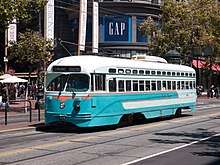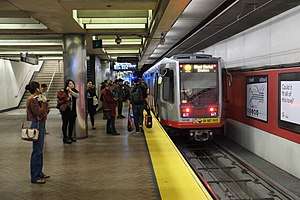Powell Street station
Powell Street is a shared Muni Metro and Bay Area Rapid Transit station near the intersection of Market Street and Powell Street in downtown San Francisco. The station is located along the Market Street Subway and extends underground from Fourth Street to Fifth Street. Hallidie Plaza connects to the station on the north side of Market Street. Like all of the shared BART and Muni stations on the Market Street Subway, the concourse mezzanine is on the first level down, an island platform for the Muni Metro is on the second level down, and the island platform for BART is on the third level down. The Powell-Mason and Powell-Hyde cable car lines turn around at Powell and Market, above the station.
BART service at Powell Street station began on November 5, 1973, followed by Muni service on February 18, 1980.[1][2] As of October 2017, Powell Street was the busiest station on weekends in the BART system.[4]
Station layout
%2C_April_2010.jpg)
Like the three other shared BART/Muni stations in the Market Street Subway, Powell station has three levels: a fare mezzanine on the first level, an island platform for Muni Metro on the second level, and an island platform for BART on the third level. As with the other three stations, Powell station was built with several entrances on each side of Market Street leading to the fare concourse. There is also a direct entrance to the fare concourse from the Westfield San Francisco Centre mall.[5] A closed passageway leads from the northeast end of the station under Market Street partway to Third Street; this was planned to be a direct entrance from the Yerba Buena Center development, but was never completed.[6][7] The fare concourse has two BART fare payment areas and two Muni Metro fare payment areas.[5] The Powell-Mason and Powell-Hyde cable car lines turn around at Powell and Market, above the station, and the F Market and Wharves streetcar line and a number of bus routes operate on the surface.
The under-construction Central Subway, expected to open in 2019, passes under the Powell station complex. The new Union Square/Market Street station will be located north of Powell station under Stockton Street. The stations will be connected outside of fare control by a passageway; the result will be a single integrated underground complex running all the way from Union Square to Market and Fifth Streets.[6][7] The Stockton/Ellis entrance to the station was closed for a planned five years on April 24, 2013, so that it could be modified to include the connection to the new station.[8] The closure was originally planned for the previous August, but delayed after Muni determined it was not yet needed.[9] Muni purchased the entrance from BART for one dollar.[10]
Following the 2015 addition of a canopy over an escalator at 19th Street Oakland station, which reduced escalator downtime by one-third, BART decided to add canopies to all downtown Oakland and San Francisco entrances.[11] The canopies will protect the escalator from weather damage, improve lighting, allow the escalator to be fully closed off when the station is not open, and provide a location for real-time train arrival information displays. The Powell station entrance at Market and Ellis was chosen for early implementation; it was closed on November 6, 2017, with an expected construction time of seven months. The remaining Powell station entrances will have similar canopies added beginning in 2019.[11]
In September 2015, BART released a report on possible modernization of the station. A total of $93 million in potential improvements were identified, including escalator replacement and canopy construction ($25 million), a corridor to Cyril Magnin ($13.7 million), a new mid-station elevator ($6.1 million), platform screen doors ($6 million), additional platform stairs ($5.6 million), and numerous other projects.[7]
Pigeons living in the station are a nuisance, which has prompted BART to take countermeasures like installing nets and metal screens to block their nesting spots. The pigeons are attracted by passengers literring and by nearby street food vendors.[12]
Transit connections

Two Muni heritage streetcar stops are located above Powell Street station: Market and 4th Street (inbound) / Market and Stockton (outbound), and Market and 5th Street. Both are served by the F Market and Wharves line. The Powell and Market turntable of the San Francisco cable car system, terminus of the Powell/Hyde and Powell/Mason lines, is located adjacent to the station next to Haladie Plaza. The station is also served by a number of Muni bus and trolleybus routes:
- Local: 5, 6, 7, 8, 9, 21, 27, 30, 31, 45
- Rapid: 5R, 9R
- Express: 7X, 8AX, 8BX, 81X
- Owl service: 91 Owl, L Owl, N Owl
AC Transit serves Powell Street station with the 800 All Nighter route during hours that BART is not operating. The station is also served by Amtrak buses connecting to trains at Emeryville station, and several private bus services including Chariot.
Additional Muni (14, 14R, 14X), Golden Gate Transit (30, 70, 101, 101X), and SamTrans (KX, 292, 397) bus routes run on Mission Street, one block away.
See also
References
- 1 2 "BART Chronology January 1947 – March 2009" (PDF). San Francisco Bay Area Rapid Transit District. March 2009. Archived from the original (PDF) on October 13, 2013.
- 1 2 Callwell, Robert (September 1999). "Transit in San Francisco: A Selected Chronology, 1850-1995" (PDF). San Francisco Municipal Railway. p. 57.
- ↑ "Monthly Ridership Reports". Bay Area Rapid Transit District. Retrieved February 6, 2017.
- ↑ "Ridership Reports". Bay Area Rapid Transit District. Retrieved October 27, 2017.
- 1 2 "Powell Street Station map". San Francisco Bay Area Rapid Transit District. Archived from the original on July 6, 2014.
- 1 2 "Chapter 2: Alternatives". Central Subway Final Supplemental Environmental Impact Statement / Supplemental Environmental Impact Report (PDF). 1. Federal Transit Administration. September 2008. pp. 2–44, 2–45.
- 1 2 3 "Powell St. BART Station Modernization Program: Final Report" (PDF). San Francisco Bay Area Rapid Transit District. September 2015.
- ↑ "Stockton and Ellis Street Entrance at Powell Street Station Closing" (Press release). San Francisco Bay Area Rapid Transit District. April 18, 2013.
- ↑ "Central Subway Construction Closes Apple Store Entrance To Powell Station". San Francisco Appeal. April 24, 2013. Retrieved September 29, 2017.
- ↑ Walker, Wilson (February 26, 2017). "KPIX Sky Drone 5 Explores the Tunnels of the Central Subway". CBS San Francisco. Retrieved October 2, 2017.
- 1 2 "SF BART and Muni Escalator/Entrance Project". San Francisco Bay Area Rapid Transit District. Archived from the original on May 19, 2018.
- ↑ Costley, Drew (August 20, 2017). "Pigeons won't stop pooping all over the Powell BART station, despite attempts to curb flocks". San Francisco Chronicle.
External links
![]()
